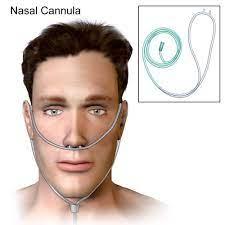The nurse observes that there are reddened areas on the cheekbones of a client receiving oxygen per nasal cannula at 3 L/minute, and the client's oxygen saturation level is 92%. Which intervention would the nurse implement?
Decrease the flow rate to 1 L/minute.
Place padding around the cannula tubing.
Apply lubricant to the cannula tubing.
Discontinue the use of the nasal cannula.
The Correct Answer is B
Choice A Reason: This is incorrect because decreasing the flow rate to 1 L/minute can compromise the client's oxygenation and worsen hypoxia. The client's oxygen saturation level is below the normal range of 95% to 100%.
Choice B Reason: This is correct because placing padding around the cannula tubing can prevent pressure ulcers and skin breakdown caused by friction and irritation from the tubing.
Choice C Reason: This is incorrect because applying lubricant to the cannula tubing can increase the risk of infection and inflammation of the nasal mucosa. Lubricant should be applied sparingly to the nares only if needed.
Choice D Reason: This is incorrect because discontinuing the use of the nasal cannula can endanger the client's life and cause respiratory failure. The client needs supplemental oxygen to maintain adequate oxygenation.

Nursing Test Bank
Naxlex Comprehensive Predictor Exams
Related Questions
Correct Answer is B
Explanation
Choice A Reason: This is incorrect because decreasing the flow rate to 1 L/minute can compromise the client's oxygenation and worsen hypoxia. The client's oxygen saturation level is below the normal range of 95% to 100%.
Choice B Reason: This is correct because placing padding around the cannula tubing can prevent pressure ulcers and skin breakdown caused by friction and irritation from the tubing.
Choice C Reason: This is incorrect because applying lubricant to the cannula tubing can increase the risk of infection and inflammation of the nasal mucosa. Lubricant should be applied sparingly to the nares only if needed.
Choice D Reason: This is incorrect because discontinuing the use of the nasal cannula can endanger the client's life and cause respiratory failure. The client needs supplemental oxygen to maintain adequate oxygenation.

Correct Answer is ["1"]
Explanation
To find the number of tablespoons, the nurse needs to convert the dose from milligrams (mg) to milliliters (mL), and then from milliliters to tablespoons. One tablespoon is equal to 15 mL.
The bottle label shows that 30 mg of dextromethorphan is equivalent to 15 mL of oral suspension. Therefore, the client needs to take 15 mL of oral suspension to get 30 mg of dextromethorphan.
Since one tablespoon is equal to 15 mL, the client needs to take one tablespoon of oral suspension with each dose.
Whether you are a student looking to ace your exams or a practicing nurse seeking to enhance your expertise , our nursing education contents will empower you with the confidence and competence to make a difference in the lives of patients and become a respected leader in the healthcare field.
Visit Naxlex, invest in your future and unlock endless possibilities with our unparalleled nursing education contents today
Report Wrong Answer on the Current Question
Do you disagree with the answer? If yes, what is your expected answer? Explain.
Kindly be descriptive with the issue you are facing.
